Team Dynamics and Organisational Behaviours
VerifiedAdded on 2023/01/03
|15
|4548
|1
AI Summary
This study material explores the concept of team dynamics and organisational behaviours. It discusses the features of effective teams and models used for building effective teams. It also examines the impact of technology on team dynamics and presents Tuckman's Team Development model and Belbin's Typology Team. The content focuses on team effectiveness and organisational behaviour in Samsung.
Contribute Materials
Your contribution can guide someone’s learning journey. Share your
documents today.
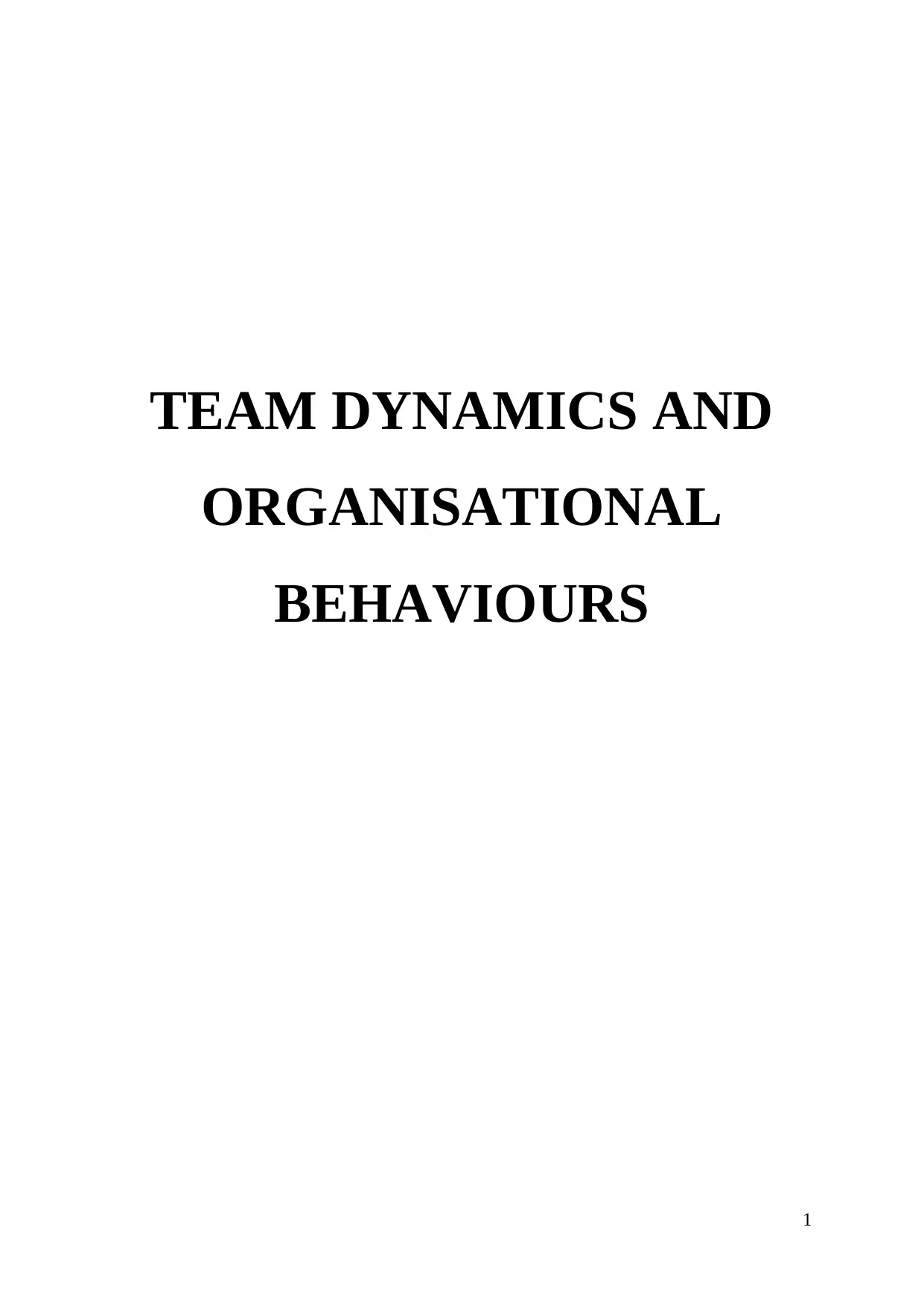
TEAM DYNAMICS AND
ORGANISATIONAL
BEHAVIOURS
1
ORGANISATIONAL
BEHAVIOURS
1
Secure Best Marks with AI Grader
Need help grading? Try our AI Grader for instant feedback on your assignments.
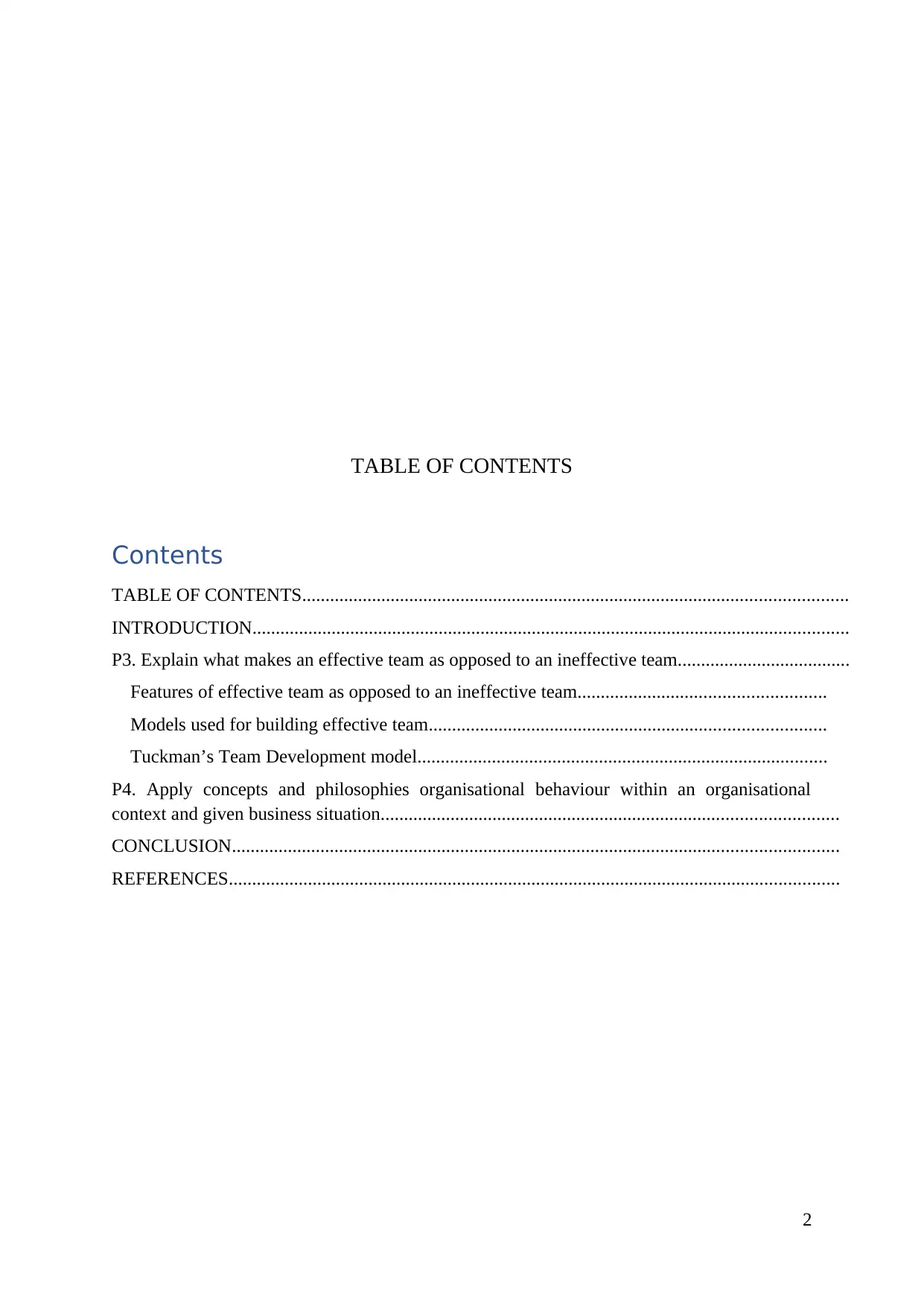
TABLE OF CONTENTS
Contents
TABLE OF CONTENTS.....................................................................................................................
INTRODUCTION................................................................................................................................
P3. Explain what makes an effective team as opposed to an ineffective team.....................................
Features of effective team as opposed to an ineffective team.....................................................
Models used for building effective team.....................................................................................
Tuckman’s Team Development model........................................................................................
P4. Apply concepts and philosophies organisational behaviour within an organisational
context and given business situation..................................................................................................
CONCLUSION..................................................................................................................................
REFERENCES...................................................................................................................................
2
Contents
TABLE OF CONTENTS.....................................................................................................................
INTRODUCTION................................................................................................................................
P3. Explain what makes an effective team as opposed to an ineffective team.....................................
Features of effective team as opposed to an ineffective team.....................................................
Models used for building effective team.....................................................................................
Tuckman’s Team Development model........................................................................................
P4. Apply concepts and philosophies organisational behaviour within an organisational
context and given business situation..................................................................................................
CONCLUSION..................................................................................................................................
REFERENCES...................................................................................................................................
2
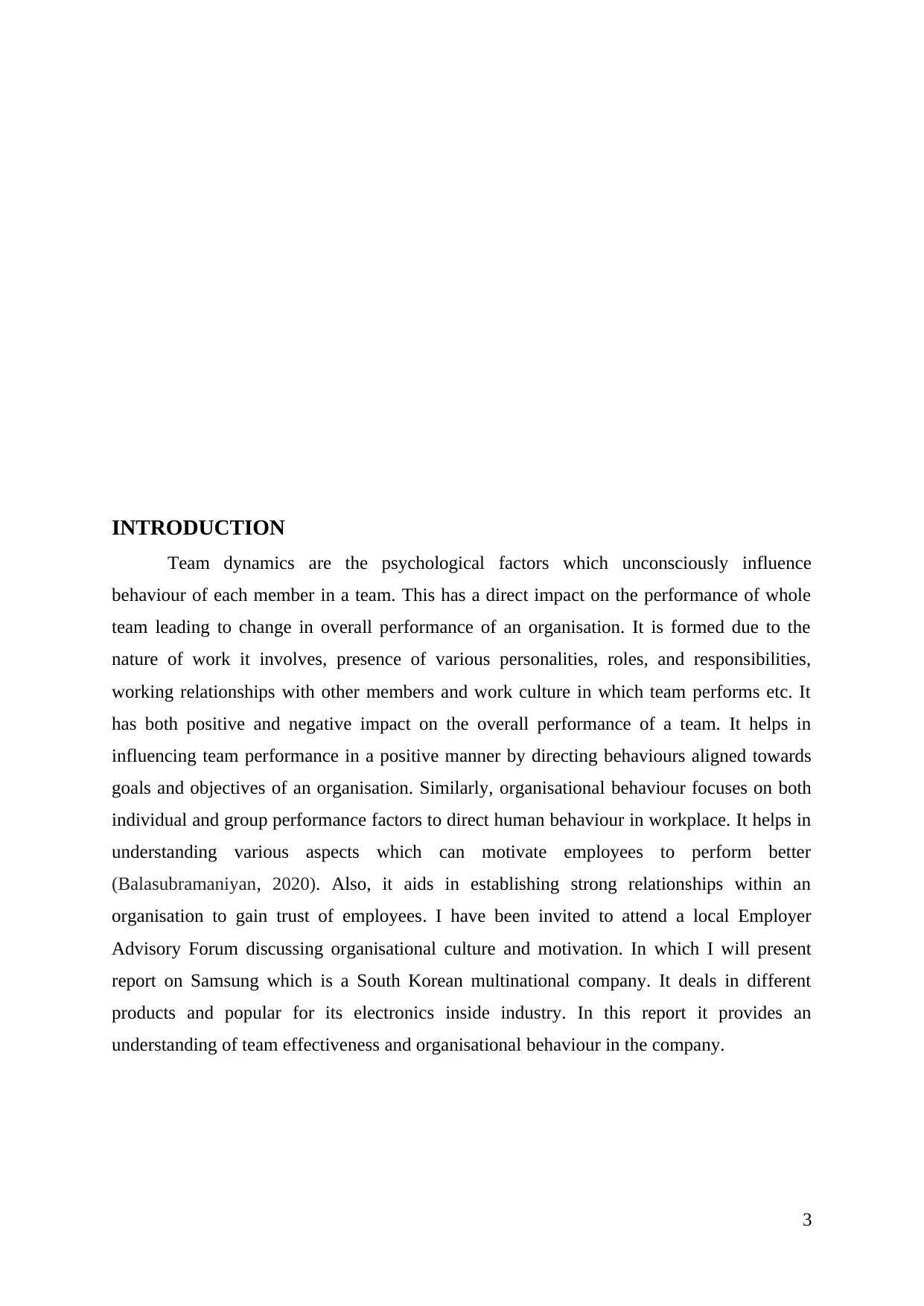
INTRODUCTION
Team dynamics are the psychological factors which unconsciously influence
behaviour of each member in a team. This has a direct impact on the performance of whole
team leading to change in overall performance of an organisation. It is formed due to the
nature of work it involves, presence of various personalities, roles, and responsibilities,
working relationships with other members and work culture in which team performs etc. It
has both positive and negative impact on the overall performance of a team. It helps in
influencing team performance in a positive manner by directing behaviours aligned towards
goals and objectives of an organisation. Similarly, organisational behaviour focuses on both
individual and group performance factors to direct human behaviour in workplace. It helps in
understanding various aspects which can motivate employees to perform better
(Balasubramaniyan, 2020). Also, it aids in establishing strong relationships within an
organisation to gain trust of employees. I have been invited to attend a local Employer
Advisory Forum discussing organisational culture and motivation. In which I will present
report on Samsung which is a South Korean multinational company. It deals in different
products and popular for its electronics inside industry. In this report it provides an
understanding of team effectiveness and organisational behaviour in the company.
3
Team dynamics are the psychological factors which unconsciously influence
behaviour of each member in a team. This has a direct impact on the performance of whole
team leading to change in overall performance of an organisation. It is formed due to the
nature of work it involves, presence of various personalities, roles, and responsibilities,
working relationships with other members and work culture in which team performs etc. It
has both positive and negative impact on the overall performance of a team. It helps in
influencing team performance in a positive manner by directing behaviours aligned towards
goals and objectives of an organisation. Similarly, organisational behaviour focuses on both
individual and group performance factors to direct human behaviour in workplace. It helps in
understanding various aspects which can motivate employees to perform better
(Balasubramaniyan, 2020). Also, it aids in establishing strong relationships within an
organisation to gain trust of employees. I have been invited to attend a local Employer
Advisory Forum discussing organisational culture and motivation. In which I will present
report on Samsung which is a South Korean multinational company. It deals in different
products and popular for its electronics inside industry. In this report it provides an
understanding of team effectiveness and organisational behaviour in the company.
3
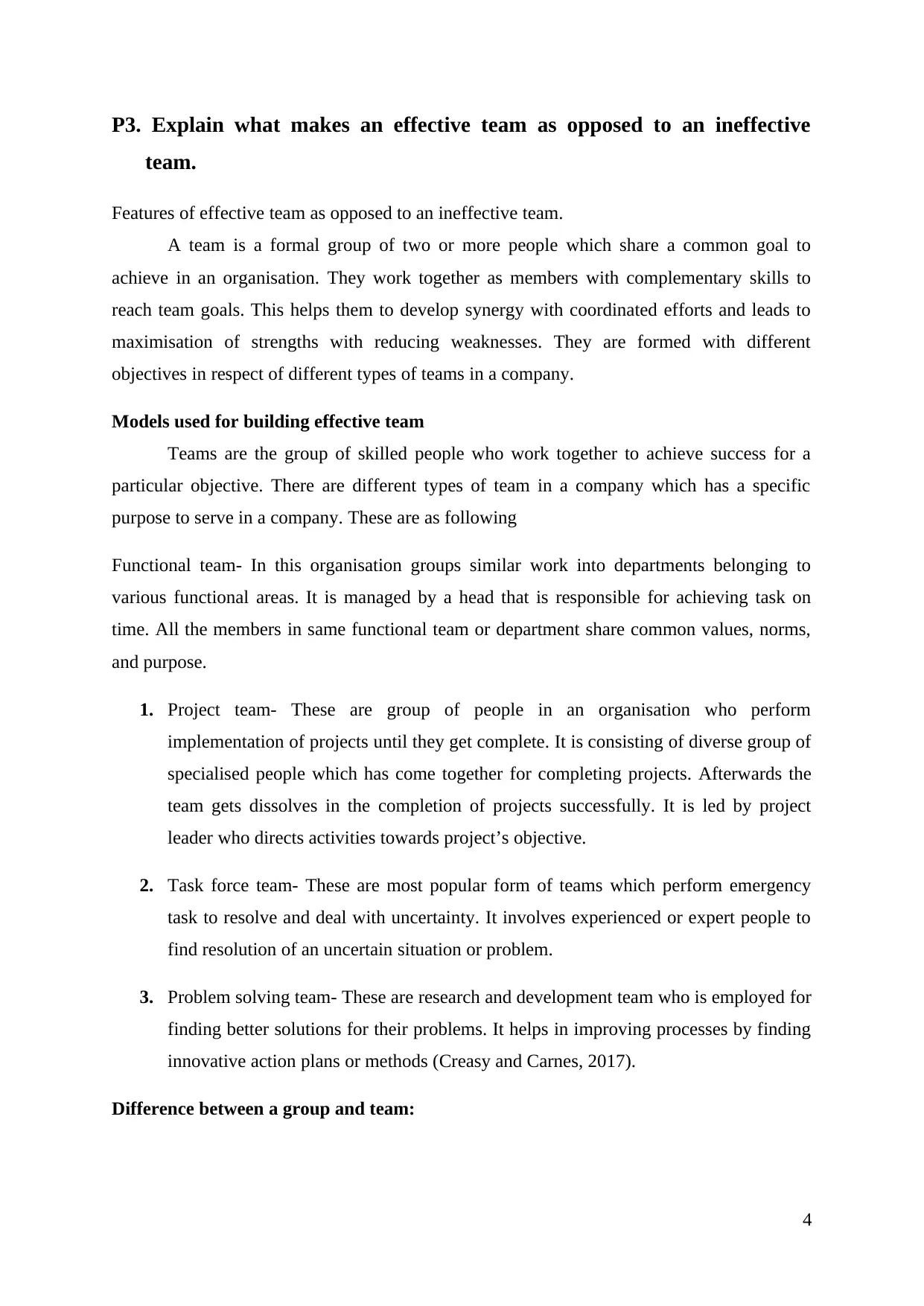
P3. Explain what makes an effective team as opposed to an ineffective
team.
Features of effective team as opposed to an ineffective team.
A team is a formal group of two or more people which share a common goal to
achieve in an organisation. They work together as members with complementary skills to
reach team goals. This helps them to develop synergy with coordinated efforts and leads to
maximisation of strengths with reducing weaknesses. They are formed with different
objectives in respect of different types of teams in a company.
Models used for building effective team
Teams are the group of skilled people who work together to achieve success for a
particular objective. There are different types of team in a company which has a specific
purpose to serve in a company. These are as following
Functional team- In this organisation groups similar work into departments belonging to
various functional areas. It is managed by a head that is responsible for achieving task on
time. All the members in same functional team or department share common values, norms,
and purpose.
1. Project team- These are group of people in an organisation who perform
implementation of projects until they get complete. It is consisting of diverse group of
specialised people which has come together for completing projects. Afterwards the
team gets dissolves in the completion of projects successfully. It is led by project
leader who directs activities towards project’s objective.
2. Task force team- These are most popular form of teams which perform emergency
task to resolve and deal with uncertainty. It involves experienced or expert people to
find resolution of an uncertain situation or problem.
3. Problem solving team- These are research and development team who is employed for
finding better solutions for their problems. It helps in improving processes by finding
innovative action plans or methods (Creasy and Carnes, 2017).
Difference between a group and team:
4
team.
Features of effective team as opposed to an ineffective team.
A team is a formal group of two or more people which share a common goal to
achieve in an organisation. They work together as members with complementary skills to
reach team goals. This helps them to develop synergy with coordinated efforts and leads to
maximisation of strengths with reducing weaknesses. They are formed with different
objectives in respect of different types of teams in a company.
Models used for building effective team
Teams are the group of skilled people who work together to achieve success for a
particular objective. There are different types of team in a company which has a specific
purpose to serve in a company. These are as following
Functional team- In this organisation groups similar work into departments belonging to
various functional areas. It is managed by a head that is responsible for achieving task on
time. All the members in same functional team or department share common values, norms,
and purpose.
1. Project team- These are group of people in an organisation who perform
implementation of projects until they get complete. It is consisting of diverse group of
specialised people which has come together for completing projects. Afterwards the
team gets dissolves in the completion of projects successfully. It is led by project
leader who directs activities towards project’s objective.
2. Task force team- These are most popular form of teams which perform emergency
task to resolve and deal with uncertainty. It involves experienced or expert people to
find resolution of an uncertain situation or problem.
3. Problem solving team- These are research and development team who is employed for
finding better solutions for their problems. It helps in improving processes by finding
innovative action plans or methods (Creasy and Carnes, 2017).
Difference between a group and team:
4
Secure Best Marks with AI Grader
Need help grading? Try our AI Grader for instant feedback on your assignments.
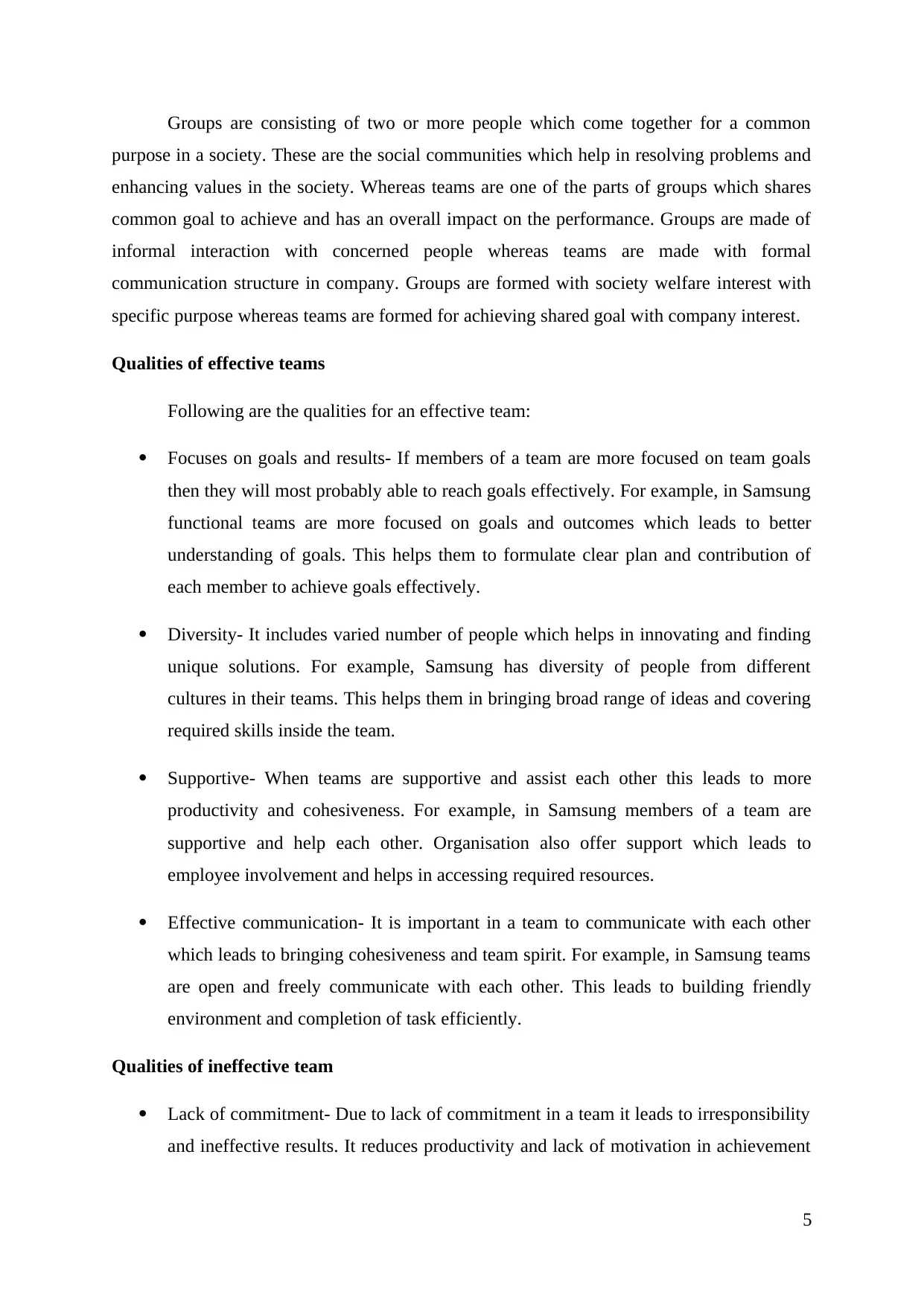
Groups are consisting of two or more people which come together for a common
purpose in a society. These are the social communities which help in resolving problems and
enhancing values in the society. Whereas teams are one of the parts of groups which shares
common goal to achieve and has an overall impact on the performance. Groups are made of
informal interaction with concerned people whereas teams are made with formal
communication structure in company. Groups are formed with society welfare interest with
specific purpose whereas teams are formed for achieving shared goal with company interest.
Qualities of effective teams
Following are the qualities for an effective team:
Focuses on goals and results- If members of a team are more focused on team goals
then they will most probably able to reach goals effectively. For example, in Samsung
functional teams are more focused on goals and outcomes which leads to better
understanding of goals. This helps them to formulate clear plan and contribution of
each member to achieve goals effectively.
Diversity- It includes varied number of people which helps in innovating and finding
unique solutions. For example, Samsung has diversity of people from different
cultures in their teams. This helps them in bringing broad range of ideas and covering
required skills inside the team.
Supportive- When teams are supportive and assist each other this leads to more
productivity and cohesiveness. For example, in Samsung members of a team are
supportive and help each other. Organisation also offer support which leads to
employee involvement and helps in accessing required resources.
Effective communication- It is important in a team to communicate with each other
which leads to bringing cohesiveness and team spirit. For example, in Samsung teams
are open and freely communicate with each other. This leads to building friendly
environment and completion of task efficiently.
Qualities of ineffective team
Lack of commitment- Due to lack of commitment in a team it leads to irresponsibility
and ineffective results. It reduces productivity and lack of motivation in achievement
5
purpose in a society. These are the social communities which help in resolving problems and
enhancing values in the society. Whereas teams are one of the parts of groups which shares
common goal to achieve and has an overall impact on the performance. Groups are made of
informal interaction with concerned people whereas teams are made with formal
communication structure in company. Groups are formed with society welfare interest with
specific purpose whereas teams are formed for achieving shared goal with company interest.
Qualities of effective teams
Following are the qualities for an effective team:
Focuses on goals and results- If members of a team are more focused on team goals
then they will most probably able to reach goals effectively. For example, in Samsung
functional teams are more focused on goals and outcomes which leads to better
understanding of goals. This helps them to formulate clear plan and contribution of
each member to achieve goals effectively.
Diversity- It includes varied number of people which helps in innovating and finding
unique solutions. For example, Samsung has diversity of people from different
cultures in their teams. This helps them in bringing broad range of ideas and covering
required skills inside the team.
Supportive- When teams are supportive and assist each other this leads to more
productivity and cohesiveness. For example, in Samsung members of a team are
supportive and help each other. Organisation also offer support which leads to
employee involvement and helps in accessing required resources.
Effective communication- It is important in a team to communicate with each other
which leads to bringing cohesiveness and team spirit. For example, in Samsung teams
are open and freely communicate with each other. This leads to building friendly
environment and completion of task efficiently.
Qualities of ineffective team
Lack of commitment- Due to lack of commitment in a team it leads to irresponsibility
and ineffective results. It reduces productivity and lack of motivation in achievement
5
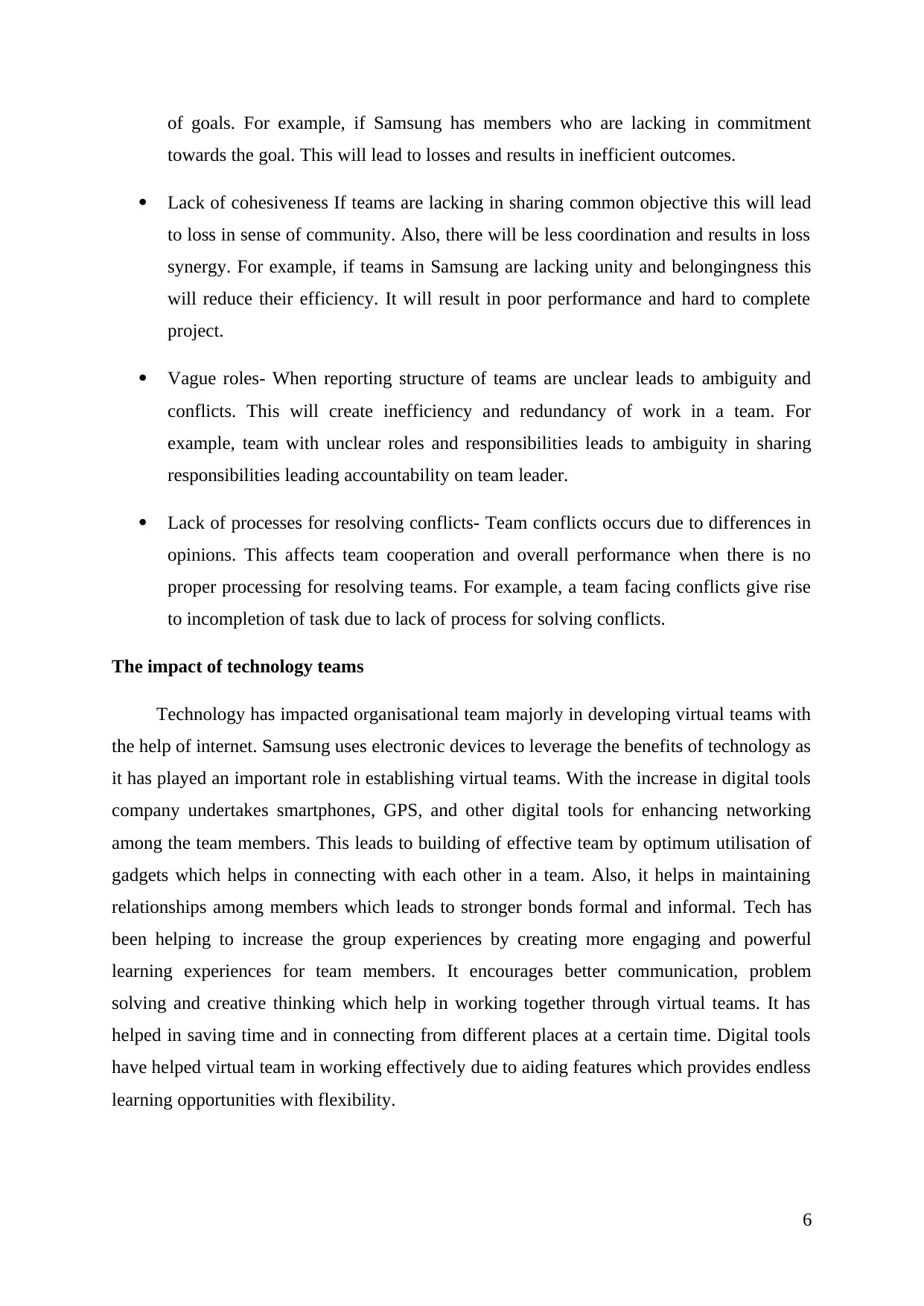
of goals. For example, if Samsung has members who are lacking in commitment
towards the goal. This will lead to losses and results in inefficient outcomes.
Lack of cohesiveness If teams are lacking in sharing common objective this will lead
to loss in sense of community. Also, there will be less coordination and results in loss
synergy. For example, if teams in Samsung are lacking unity and belongingness this
will reduce their efficiency. It will result in poor performance and hard to complete
project.
Vague roles- When reporting structure of teams are unclear leads to ambiguity and
conflicts. This will create inefficiency and redundancy of work in a team. For
example, team with unclear roles and responsibilities leads to ambiguity in sharing
responsibilities leading accountability on team leader.
Lack of processes for resolving conflicts- Team conflicts occurs due to differences in
opinions. This affects team cooperation and overall performance when there is no
proper processing for resolving teams. For example, a team facing conflicts give rise
to incompletion of task due to lack of process for solving conflicts.
The impact of technology teams
Technology has impacted organisational team majorly in developing virtual teams with
the help of internet. Samsung uses electronic devices to leverage the benefits of technology as
it has played an important role in establishing virtual teams. With the increase in digital tools
company undertakes smartphones, GPS, and other digital tools for enhancing networking
among the team members. This leads to building of effective team by optimum utilisation of
gadgets which helps in connecting with each other in a team. Also, it helps in maintaining
relationships among members which leads to stronger bonds formal and informal. Tech has
been helping to increase the group experiences by creating more engaging and powerful
learning experiences for team members. It encourages better communication, problem
solving and creative thinking which help in working together through virtual teams. It has
helped in saving time and in connecting from different places at a certain time. Digital tools
have helped virtual team in working effectively due to aiding features which provides endless
learning opportunities with flexibility.
6
towards the goal. This will lead to losses and results in inefficient outcomes.
Lack of cohesiveness If teams are lacking in sharing common objective this will lead
to loss in sense of community. Also, there will be less coordination and results in loss
synergy. For example, if teams in Samsung are lacking unity and belongingness this
will reduce their efficiency. It will result in poor performance and hard to complete
project.
Vague roles- When reporting structure of teams are unclear leads to ambiguity and
conflicts. This will create inefficiency and redundancy of work in a team. For
example, team with unclear roles and responsibilities leads to ambiguity in sharing
responsibilities leading accountability on team leader.
Lack of processes for resolving conflicts- Team conflicts occurs due to differences in
opinions. This affects team cooperation and overall performance when there is no
proper processing for resolving teams. For example, a team facing conflicts give rise
to incompletion of task due to lack of process for solving conflicts.
The impact of technology teams
Technology has impacted organisational team majorly in developing virtual teams with
the help of internet. Samsung uses electronic devices to leverage the benefits of technology as
it has played an important role in establishing virtual teams. With the increase in digital tools
company undertakes smartphones, GPS, and other digital tools for enhancing networking
among the team members. This leads to building of effective team by optimum utilisation of
gadgets which helps in connecting with each other in a team. Also, it helps in maintaining
relationships among members which leads to stronger bonds formal and informal. Tech has
been helping to increase the group experiences by creating more engaging and powerful
learning experiences for team members. It encourages better communication, problem
solving and creative thinking which help in working together through virtual teams. It has
helped in saving time and in connecting from different places at a certain time. Digital tools
have helped virtual team in working effectively due to aiding features which provides endless
learning opportunities with flexibility.
6
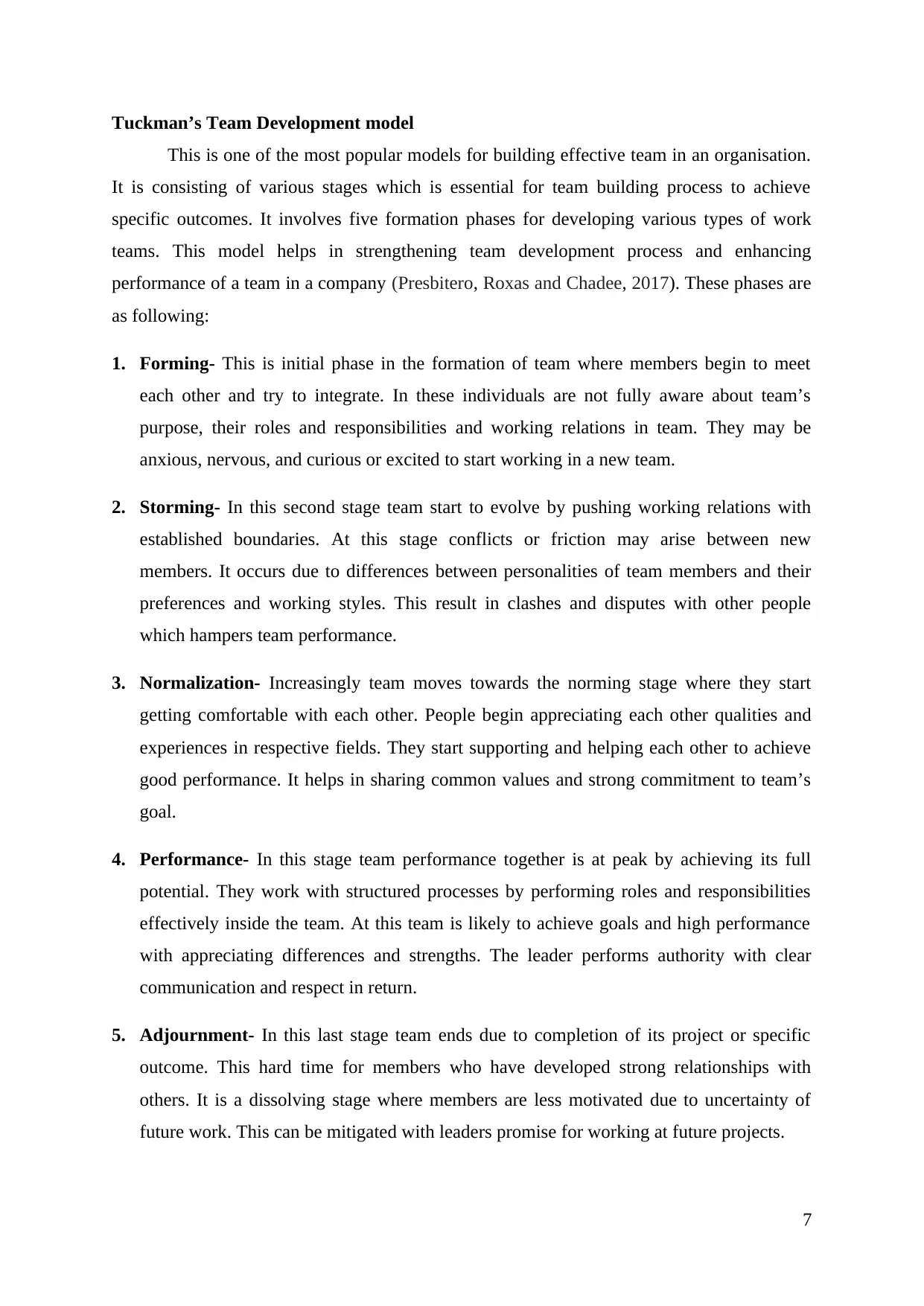
Tuckman’s Team Development model
This is one of the most popular models for building effective team in an organisation.
It is consisting of various stages which is essential for team building process to achieve
specific outcomes. It involves five formation phases for developing various types of work
teams. This model helps in strengthening team development process and enhancing
performance of a team in a company (Presbitero, Roxas and Chadee, 2017). These phases are
as following:
1. Forming- This is initial phase in the formation of team where members begin to meet
each other and try to integrate. In these individuals are not fully aware about team’s
purpose, their roles and responsibilities and working relations in team. They may be
anxious, nervous, and curious or excited to start working in a new team.
2. Storming- In this second stage team start to evolve by pushing working relations with
established boundaries. At this stage conflicts or friction may arise between new
members. It occurs due to differences between personalities of team members and their
preferences and working styles. This result in clashes and disputes with other people
which hampers team performance.
3. Normalization- Increasingly team moves towards the norming stage where they start
getting comfortable with each other. People begin appreciating each other qualities and
experiences in respective fields. They start supporting and helping each other to achieve
good performance. It helps in sharing common values and strong commitment to team’s
goal.
4. Performance- In this stage team performance together is at peak by achieving its full
potential. They work with structured processes by performing roles and responsibilities
effectively inside the team. At this team is likely to achieve goals and high performance
with appreciating differences and strengths. The leader performs authority with clear
communication and respect in return.
5. Adjournment- In this last stage team ends due to completion of its project or specific
outcome. This hard time for members who have developed strong relationships with
others. It is a dissolving stage where members are less motivated due to uncertainty of
future work. This can be mitigated with leaders promise for working at future projects.
7
This is one of the most popular models for building effective team in an organisation.
It is consisting of various stages which is essential for team building process to achieve
specific outcomes. It involves five formation phases for developing various types of work
teams. This model helps in strengthening team development process and enhancing
performance of a team in a company (Presbitero, Roxas and Chadee, 2017). These phases are
as following:
1. Forming- This is initial phase in the formation of team where members begin to meet
each other and try to integrate. In these individuals are not fully aware about team’s
purpose, their roles and responsibilities and working relations in team. They may be
anxious, nervous, and curious or excited to start working in a new team.
2. Storming- In this second stage team start to evolve by pushing working relations with
established boundaries. At this stage conflicts or friction may arise between new
members. It occurs due to differences between personalities of team members and their
preferences and working styles. This result in clashes and disputes with other people
which hampers team performance.
3. Normalization- Increasingly team moves towards the norming stage where they start
getting comfortable with each other. People begin appreciating each other qualities and
experiences in respective fields. They start supporting and helping each other to achieve
good performance. It helps in sharing common values and strong commitment to team’s
goal.
4. Performance- In this stage team performance together is at peak by achieving its full
potential. They work with structured processes by performing roles and responsibilities
effectively inside the team. At this team is likely to achieve goals and high performance
with appreciating differences and strengths. The leader performs authority with clear
communication and respect in return.
5. Adjournment- In this last stage team ends due to completion of its project or specific
outcome. This hard time for members who have developed strong relationships with
others. It is a dissolving stage where members are less motivated due to uncertainty of
future work. This can be mitigated with leaders promise for working at future projects.
7
Paraphrase This Document
Need a fresh take? Get an instant paraphrase of this document with our AI Paraphraser
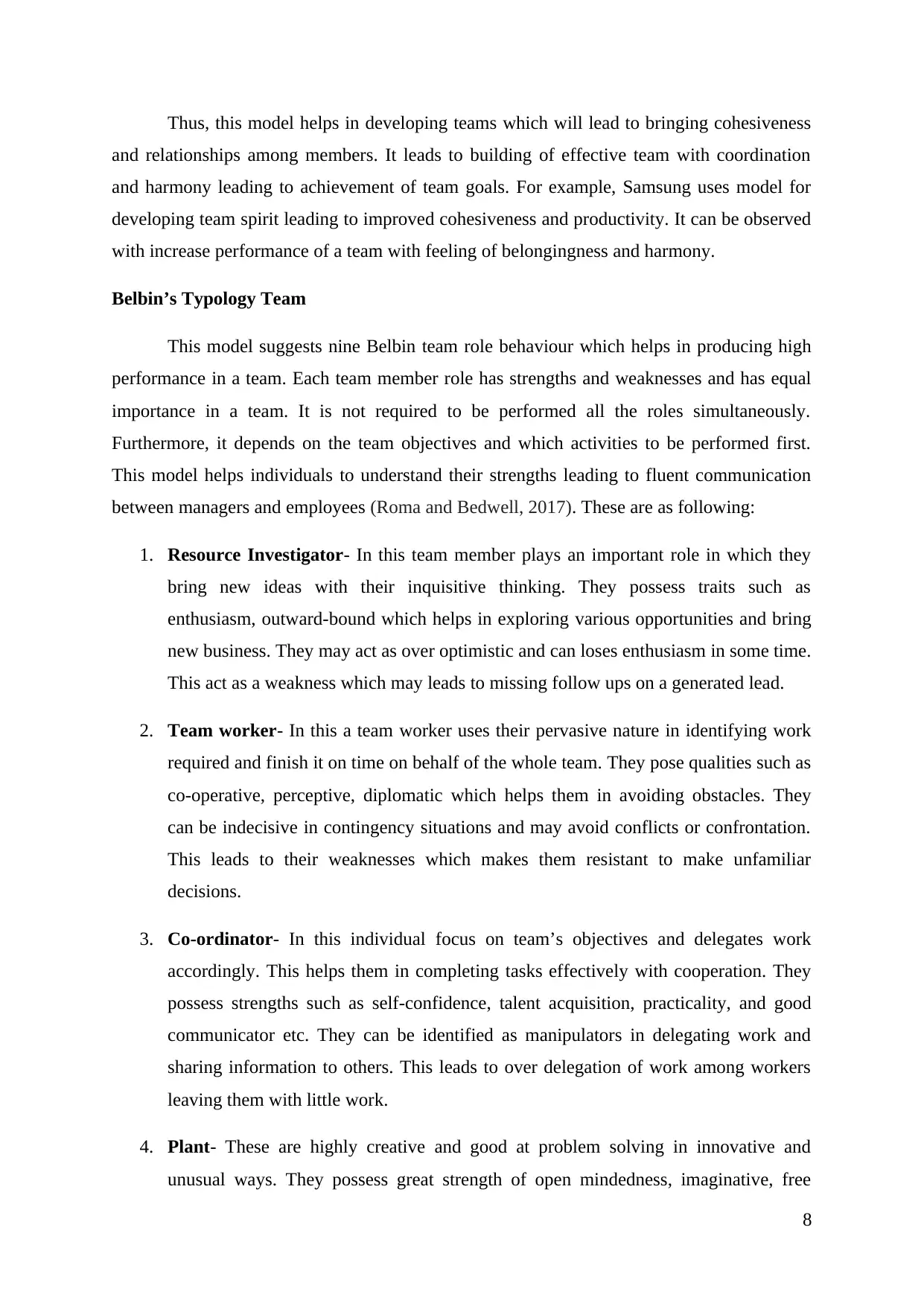
Thus, this model helps in developing teams which will lead to bringing cohesiveness
and relationships among members. It leads to building of effective team with coordination
and harmony leading to achievement of team goals. For example, Samsung uses model for
developing team spirit leading to improved cohesiveness and productivity. It can be observed
with increase performance of a team with feeling of belongingness and harmony.
Belbin’s Typology Team
This model suggests nine Belbin team role behaviour which helps in producing high
performance in a team. Each team member role has strengths and weaknesses and has equal
importance in a team. It is not required to be performed all the roles simultaneously.
Furthermore, it depends on the team objectives and which activities to be performed first.
This model helps individuals to understand their strengths leading to fluent communication
between managers and employees (Roma and Bedwell, 2017). These are as following:
1. Resource Investigator- In this team member plays an important role in which they
bring new ideas with their inquisitive thinking. They possess traits such as
enthusiasm, outward-bound which helps in exploring various opportunities and bring
new business. They may act as over optimistic and can loses enthusiasm in some time.
This act as a weakness which may leads to missing follow ups on a generated lead.
2. Team worker- In this a team worker uses their pervasive nature in identifying work
required and finish it on time on behalf of the whole team. They pose qualities such as
co-operative, perceptive, diplomatic which helps them in avoiding obstacles. They
can be indecisive in contingency situations and may avoid conflicts or confrontation.
This leads to their weaknesses which makes them resistant to make unfamiliar
decisions.
3. Co-ordinator- In this individual focus on team’s objectives and delegates work
accordingly. This helps them in completing tasks effectively with cooperation. They
possess strengths such as self-confidence, talent acquisition, practicality, and good
communicator etc. They can be identified as manipulators in delegating work and
sharing information to others. This leads to over delegation of work among workers
leaving them with little work.
4. Plant- These are highly creative and good at problem solving in innovative and
unusual ways. They possess great strength of open mindedness, imaginative, free
8
and relationships among members. It leads to building of effective team with coordination
and harmony leading to achievement of team goals. For example, Samsung uses model for
developing team spirit leading to improved cohesiveness and productivity. It can be observed
with increase performance of a team with feeling of belongingness and harmony.
Belbin’s Typology Team
This model suggests nine Belbin team role behaviour which helps in producing high
performance in a team. Each team member role has strengths and weaknesses and has equal
importance in a team. It is not required to be performed all the roles simultaneously.
Furthermore, it depends on the team objectives and which activities to be performed first.
This model helps individuals to understand their strengths leading to fluent communication
between managers and employees (Roma and Bedwell, 2017). These are as following:
1. Resource Investigator- In this team member plays an important role in which they
bring new ideas with their inquisitive thinking. They possess traits such as
enthusiasm, outward-bound which helps in exploring various opportunities and bring
new business. They may act as over optimistic and can loses enthusiasm in some time.
This act as a weakness which may leads to missing follow ups on a generated lead.
2. Team worker- In this a team worker uses their pervasive nature in identifying work
required and finish it on time on behalf of the whole team. They pose qualities such as
co-operative, perceptive, diplomatic which helps them in avoiding obstacles. They
can be indecisive in contingency situations and may avoid conflicts or confrontation.
This leads to their weaknesses which makes them resistant to make unfamiliar
decisions.
3. Co-ordinator- In this individual focus on team’s objectives and delegates work
accordingly. This helps them in completing tasks effectively with cooperation. They
possess strengths such as self-confidence, talent acquisition, practicality, and good
communicator etc. They can be identified as manipulators in delegating work and
sharing information to others. This leads to over delegation of work among workers
leaving them with little work.
4. Plant- These are highly creative and good at problem solving in innovative and
unusual ways. They possess great strength of open mindedness, imaginative, free
8
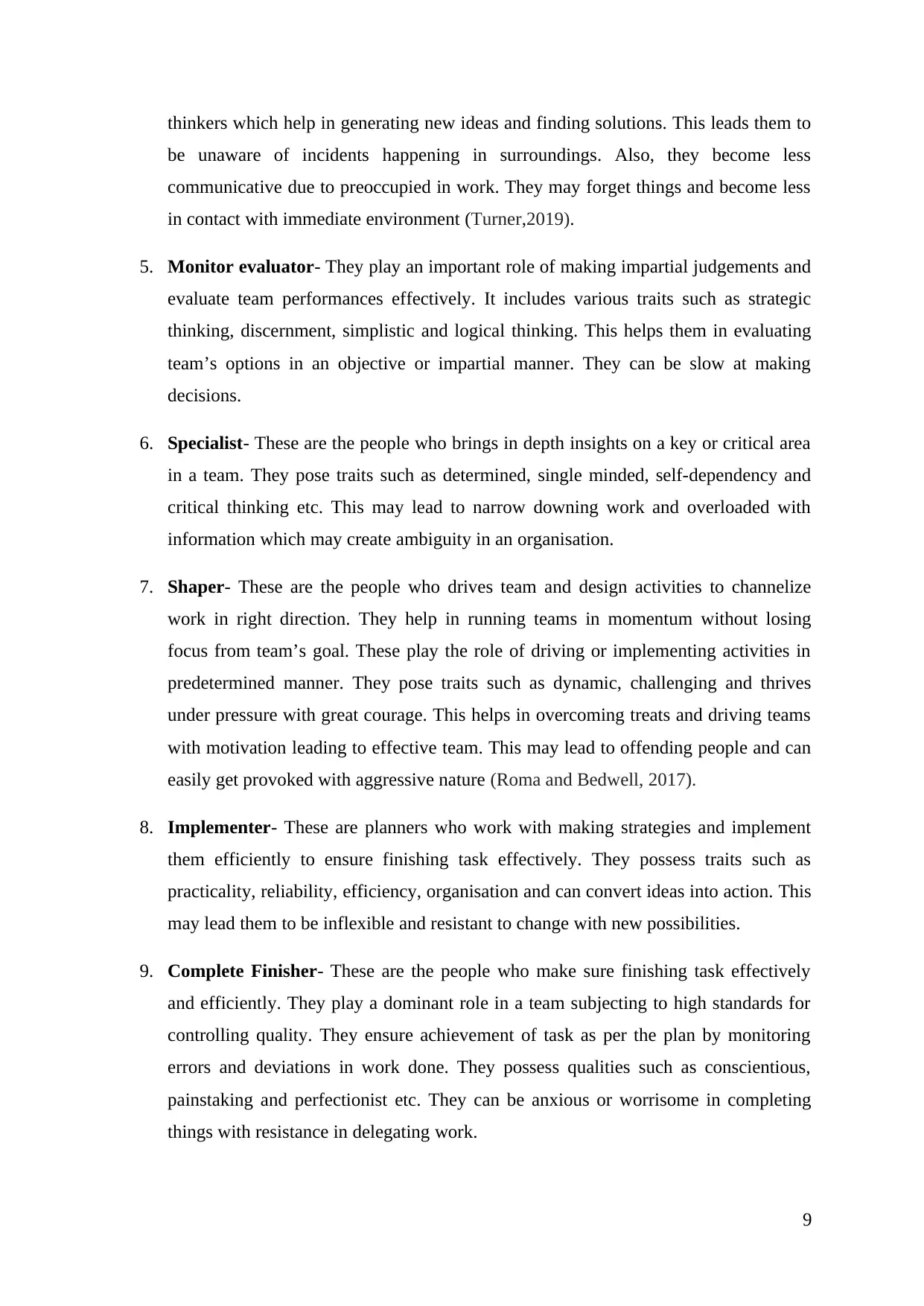
thinkers which help in generating new ideas and finding solutions. This leads them to
be unaware of incidents happening in surroundings. Also, they become less
communicative due to preoccupied in work. They may forget things and become less
in contact with immediate environment (Turner,2019).
5. Monitor evaluator- They play an important role of making impartial judgements and
evaluate team performances effectively. It includes various traits such as strategic
thinking, discernment, simplistic and logical thinking. This helps them in evaluating
team’s options in an objective or impartial manner. They can be slow at making
decisions.
6. Specialist- These are the people who brings in depth insights on a key or critical area
in a team. They pose traits such as determined, single minded, self-dependency and
critical thinking etc. This may lead to narrow downing work and overloaded with
information which may create ambiguity in an organisation.
7. Shaper- These are the people who drives team and design activities to channelize
work in right direction. They help in running teams in momentum without losing
focus from team’s goal. These play the role of driving or implementing activities in
predetermined manner. They pose traits such as dynamic, challenging and thrives
under pressure with great courage. This helps in overcoming treats and driving teams
with motivation leading to effective team. This may lead to offending people and can
easily get provoked with aggressive nature (Roma and Bedwell, 2017).
8. Implementer- These are planners who work with making strategies and implement
them efficiently to ensure finishing task effectively. They possess traits such as
practicality, reliability, efficiency, organisation and can convert ideas into action. This
may lead them to be inflexible and resistant to change with new possibilities.
9. Complete Finisher- These are the people who make sure finishing task effectively
and efficiently. They play a dominant role in a team subjecting to high standards for
controlling quality. They ensure achievement of task as per the plan by monitoring
errors and deviations in work done. They possess qualities such as conscientious,
painstaking and perfectionist etc. They can be anxious or worrisome in completing
things with resistance in delegating work.
9
be unaware of incidents happening in surroundings. Also, they become less
communicative due to preoccupied in work. They may forget things and become less
in contact with immediate environment (Turner,2019).
5. Monitor evaluator- They play an important role of making impartial judgements and
evaluate team performances effectively. It includes various traits such as strategic
thinking, discernment, simplistic and logical thinking. This helps them in evaluating
team’s options in an objective or impartial manner. They can be slow at making
decisions.
6. Specialist- These are the people who brings in depth insights on a key or critical area
in a team. They pose traits such as determined, single minded, self-dependency and
critical thinking etc. This may lead to narrow downing work and overloaded with
information which may create ambiguity in an organisation.
7. Shaper- These are the people who drives team and design activities to channelize
work in right direction. They help in running teams in momentum without losing
focus from team’s goal. These play the role of driving or implementing activities in
predetermined manner. They pose traits such as dynamic, challenging and thrives
under pressure with great courage. This helps in overcoming treats and driving teams
with motivation leading to effective team. This may lead to offending people and can
easily get provoked with aggressive nature (Roma and Bedwell, 2017).
8. Implementer- These are planners who work with making strategies and implement
them efficiently to ensure finishing task effectively. They possess traits such as
practicality, reliability, efficiency, organisation and can convert ideas into action. This
may lead them to be inflexible and resistant to change with new possibilities.
9. Complete Finisher- These are the people who make sure finishing task effectively
and efficiently. They play a dominant role in a team subjecting to high standards for
controlling quality. They ensure achievement of task as per the plan by monitoring
errors and deviations in work done. They possess qualities such as conscientious,
painstaking and perfectionist etc. They can be anxious or worrisome in completing
things with resistance in delegating work.
9
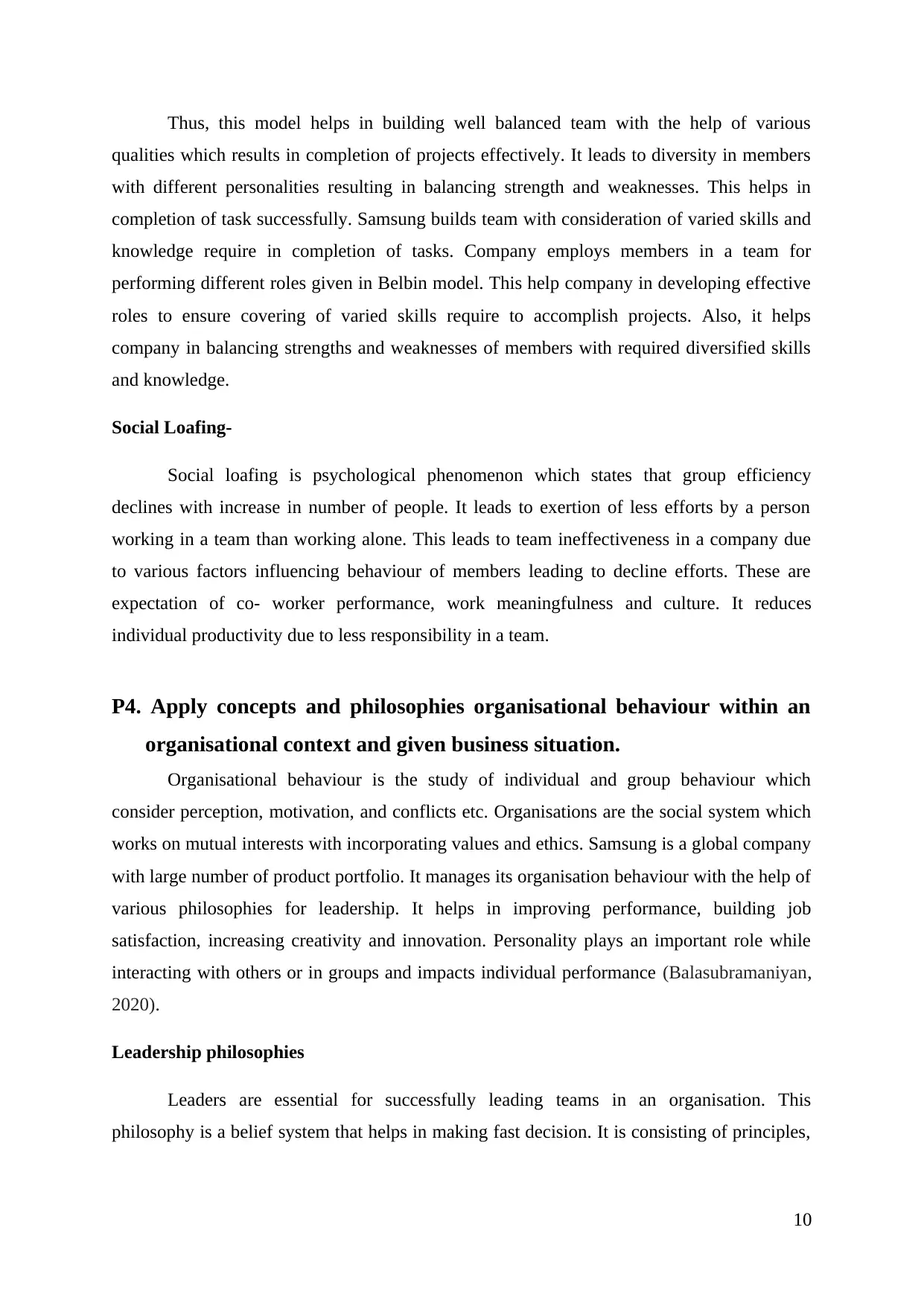
Thus, this model helps in building well balanced team with the help of various
qualities which results in completion of projects effectively. It leads to diversity in members
with different personalities resulting in balancing strength and weaknesses. This helps in
completion of task successfully. Samsung builds team with consideration of varied skills and
knowledge require in completion of tasks. Company employs members in a team for
performing different roles given in Belbin model. This help company in developing effective
roles to ensure covering of varied skills require to accomplish projects. Also, it helps
company in balancing strengths and weaknesses of members with required diversified skills
and knowledge.
Social Loafing-
Social loafing is psychological phenomenon which states that group efficiency
declines with increase in number of people. It leads to exertion of less efforts by a person
working in a team than working alone. This leads to team ineffectiveness in a company due
to various factors influencing behaviour of members leading to decline efforts. These are
expectation of co- worker performance, work meaningfulness and culture. It reduces
individual productivity due to less responsibility in a team.
P4. Apply concepts and philosophies organisational behaviour within an
organisational context and given business situation.
Organisational behaviour is the study of individual and group behaviour which
consider perception, motivation, and conflicts etc. Organisations are the social system which
works on mutual interests with incorporating values and ethics. Samsung is a global company
with large number of product portfolio. It manages its organisation behaviour with the help of
various philosophies for leadership. It helps in improving performance, building job
satisfaction, increasing creativity and innovation. Personality plays an important role while
interacting with others or in groups and impacts individual performance (Balasubramaniyan,
2020).
Leadership philosophies
Leaders are essential for successfully leading teams in an organisation. This
philosophy is a belief system that helps in making fast decision. It is consisting of principles,
10
qualities which results in completion of projects effectively. It leads to diversity in members
with different personalities resulting in balancing strength and weaknesses. This helps in
completion of task successfully. Samsung builds team with consideration of varied skills and
knowledge require in completion of tasks. Company employs members in a team for
performing different roles given in Belbin model. This help company in developing effective
roles to ensure covering of varied skills require to accomplish projects. Also, it helps
company in balancing strengths and weaknesses of members with required diversified skills
and knowledge.
Social Loafing-
Social loafing is psychological phenomenon which states that group efficiency
declines with increase in number of people. It leads to exertion of less efforts by a person
working in a team than working alone. This leads to team ineffectiveness in a company due
to various factors influencing behaviour of members leading to decline efforts. These are
expectation of co- worker performance, work meaningfulness and culture. It reduces
individual productivity due to less responsibility in a team.
P4. Apply concepts and philosophies organisational behaviour within an
organisational context and given business situation.
Organisational behaviour is the study of individual and group behaviour which
consider perception, motivation, and conflicts etc. Organisations are the social system which
works on mutual interests with incorporating values and ethics. Samsung is a global company
with large number of product portfolio. It manages its organisation behaviour with the help of
various philosophies for leadership. It helps in improving performance, building job
satisfaction, increasing creativity and innovation. Personality plays an important role while
interacting with others or in groups and impacts individual performance (Balasubramaniyan,
2020).
Leadership philosophies
Leaders are essential for successfully leading teams in an organisation. This
philosophy is a belief system that helps in making fast decision. It is consisting of principles,
10
Secure Best Marks with AI Grader
Need help grading? Try our AI Grader for instant feedback on your assignments.
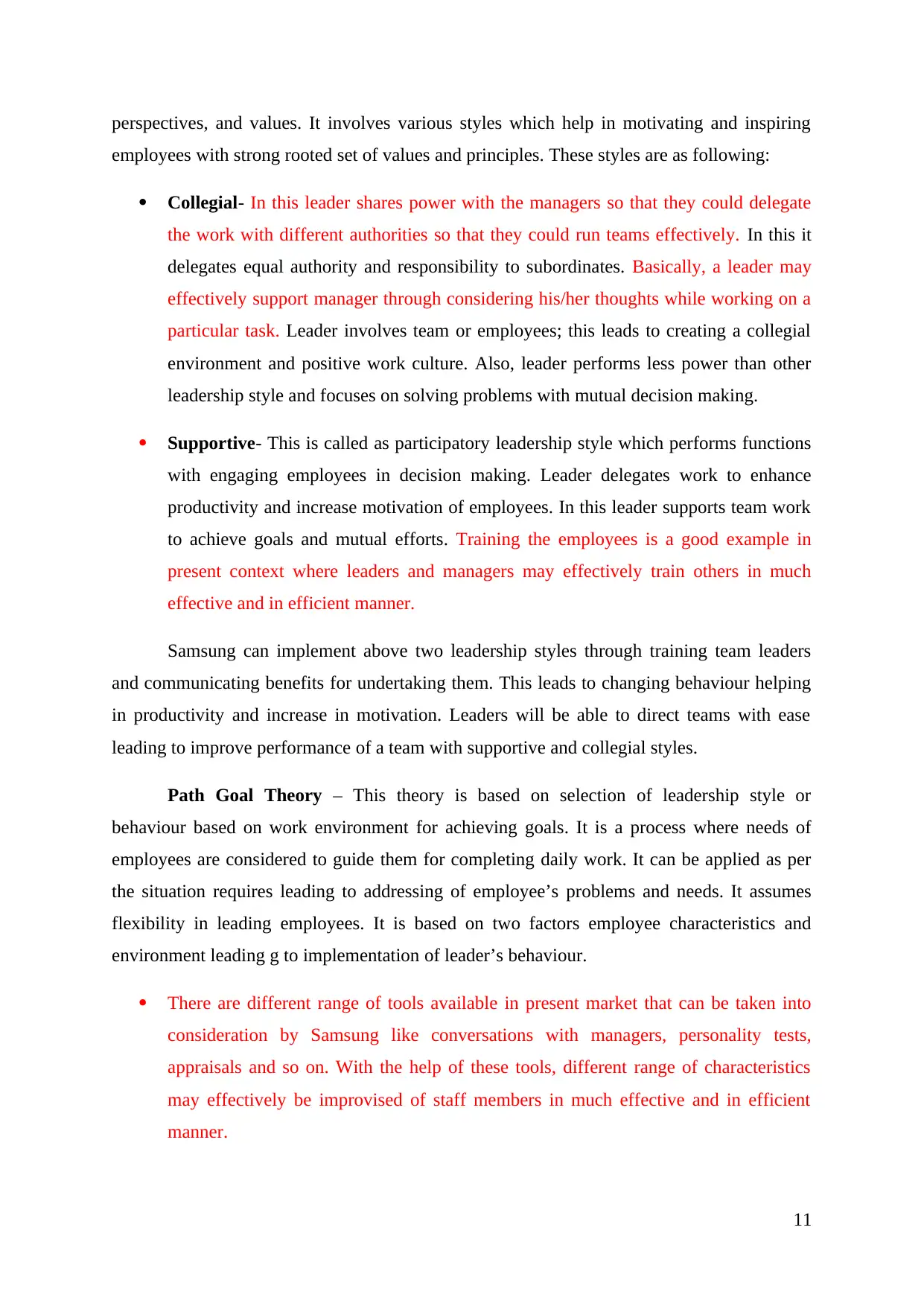
perspectives, and values. It involves various styles which help in motivating and inspiring
employees with strong rooted set of values and principles. These styles are as following:
Collegial- In this leader shares power with the managers so that they could delegate
the work with different authorities so that they could run teams effectively. In this it
delegates equal authority and responsibility to subordinates. Basically, a leader may
effectively support manager through considering his/her thoughts while working on a
particular task. Leader involves team or employees; this leads to creating a collegial
environment and positive work culture. Also, leader performs less power than other
leadership style and focuses on solving problems with mutual decision making.
Supportive- This is called as participatory leadership style which performs functions
with engaging employees in decision making. Leader delegates work to enhance
productivity and increase motivation of employees. In this leader supports team work
to achieve goals and mutual efforts. Training the employees is a good example in
present context where leaders and managers may effectively train others in much
effective and in efficient manner.
Samsung can implement above two leadership styles through training team leaders
and communicating benefits for undertaking them. This leads to changing behaviour helping
in productivity and increase in motivation. Leaders will be able to direct teams with ease
leading to improve performance of a team with supportive and collegial styles.
Path Goal Theory – This theory is based on selection of leadership style or
behaviour based on work environment for achieving goals. It is a process where needs of
employees are considered to guide them for completing daily work. It can be applied as per
the situation requires leading to addressing of employee’s problems and needs. It assumes
flexibility in leading employees. It is based on two factors employee characteristics and
environment leading g to implementation of leader’s behaviour.
There are different range of tools available in present market that can be taken into
consideration by Samsung like conversations with managers, personality tests,
appraisals and so on. With the help of these tools, different range of characteristics
may effectively be improvised of staff members in much effective and in efficient
manner.
11
employees with strong rooted set of values and principles. These styles are as following:
Collegial- In this leader shares power with the managers so that they could delegate
the work with different authorities so that they could run teams effectively. In this it
delegates equal authority and responsibility to subordinates. Basically, a leader may
effectively support manager through considering his/her thoughts while working on a
particular task. Leader involves team or employees; this leads to creating a collegial
environment and positive work culture. Also, leader performs less power than other
leadership style and focuses on solving problems with mutual decision making.
Supportive- This is called as participatory leadership style which performs functions
with engaging employees in decision making. Leader delegates work to enhance
productivity and increase motivation of employees. In this leader supports team work
to achieve goals and mutual efforts. Training the employees is a good example in
present context where leaders and managers may effectively train others in much
effective and in efficient manner.
Samsung can implement above two leadership styles through training team leaders
and communicating benefits for undertaking them. This leads to changing behaviour helping
in productivity and increase in motivation. Leaders will be able to direct teams with ease
leading to improve performance of a team with supportive and collegial styles.
Path Goal Theory – This theory is based on selection of leadership style or
behaviour based on work environment for achieving goals. It is a process where needs of
employees are considered to guide them for completing daily work. It can be applied as per
the situation requires leading to addressing of employee’s problems and needs. It assumes
flexibility in leading employees. It is based on two factors employee characteristics and
environment leading g to implementation of leader’s behaviour.
There are different range of tools available in present market that can be taken into
consideration by Samsung like conversations with managers, personality tests,
appraisals and so on. With the help of these tools, different range of characteristics
may effectively be improvised of staff members in much effective and in efficient
manner.
11
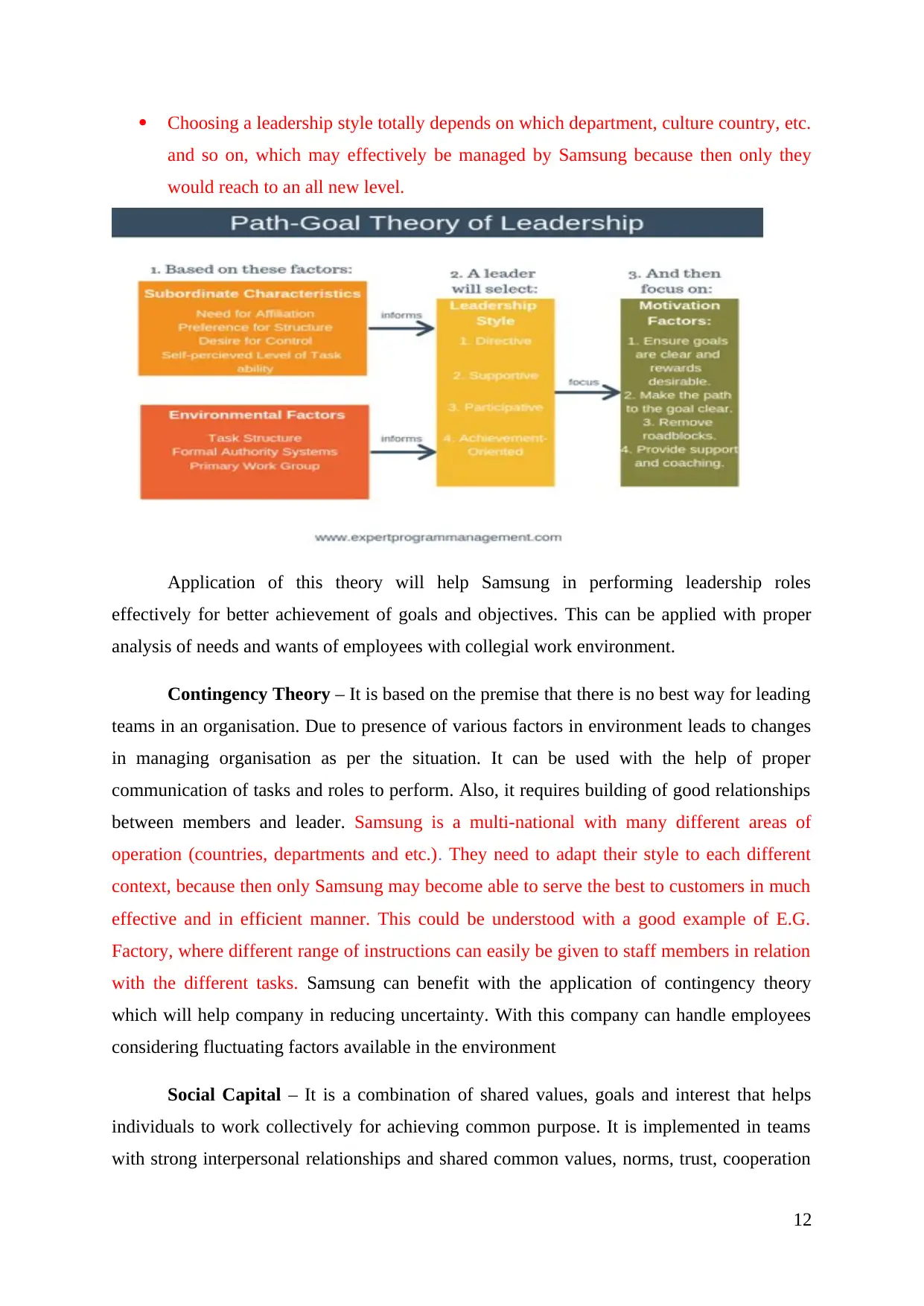
Choosing a leadership style totally depends on which department, culture country, etc.
and so on, which may effectively be managed by Samsung because then only they
would reach to an all new level.
Application of this theory will help Samsung in performing leadership roles
effectively for better achievement of goals and objectives. This can be applied with proper
analysis of needs and wants of employees with collegial work environment.
Contingency Theory – It is based on the premise that there is no best way for leading
teams in an organisation. Due to presence of various factors in environment leads to changes
in managing organisation as per the situation. It can be used with the help of proper
communication of tasks and roles to perform. Also, it requires building of good relationships
between members and leader. Samsung is a multi-national with many different areas of
operation (countries, departments and etc.). They need to adapt their style to each different
context, because then only Samsung may become able to serve the best to customers in much
effective and in efficient manner. This could be understood with a good example of E.G.
Factory, where different range of instructions can easily be given to staff members in relation
with the different tasks. Samsung can benefit with the application of contingency theory
which will help company in reducing uncertainty. With this company can handle employees
considering fluctuating factors available in the environment
Social Capital – It is a combination of shared values, goals and interest that helps
individuals to work collectively for achieving common purpose. It is implemented in teams
with strong interpersonal relationships and shared common values, norms, trust, cooperation
12
and so on, which may effectively be managed by Samsung because then only they
would reach to an all new level.
Application of this theory will help Samsung in performing leadership roles
effectively for better achievement of goals and objectives. This can be applied with proper
analysis of needs and wants of employees with collegial work environment.
Contingency Theory – It is based on the premise that there is no best way for leading
teams in an organisation. Due to presence of various factors in environment leads to changes
in managing organisation as per the situation. It can be used with the help of proper
communication of tasks and roles to perform. Also, it requires building of good relationships
between members and leader. Samsung is a multi-national with many different areas of
operation (countries, departments and etc.). They need to adapt their style to each different
context, because then only Samsung may become able to serve the best to customers in much
effective and in efficient manner. This could be understood with a good example of E.G.
Factory, where different range of instructions can easily be given to staff members in relation
with the different tasks. Samsung can benefit with the application of contingency theory
which will help company in reducing uncertainty. With this company can handle employees
considering fluctuating factors available in the environment
Social Capital – It is a combination of shared values, goals and interest that helps
individuals to work collectively for achieving common purpose. It is implemented in teams
with strong interpersonal relationships and shared common values, norms, trust, cooperation
12
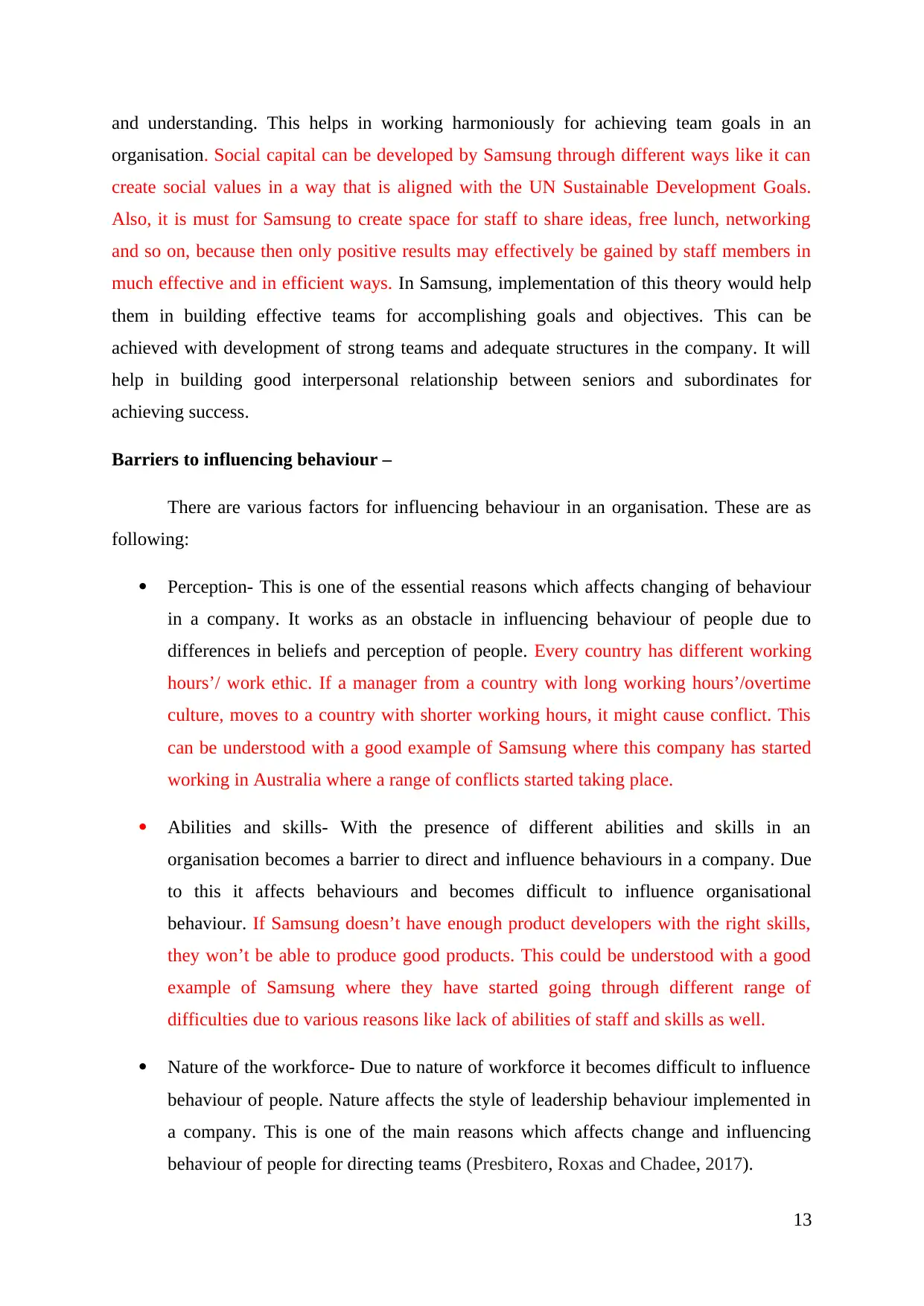
and understanding. This helps in working harmoniously for achieving team goals in an
organisation. Social capital can be developed by Samsung through different ways like it can
create social values in a way that is aligned with the UN Sustainable Development Goals.
Also, it is must for Samsung to create space for staff to share ideas, free lunch, networking
and so on, because then only positive results may effectively be gained by staff members in
much effective and in efficient ways. In Samsung, implementation of this theory would help
them in building effective teams for accomplishing goals and objectives. This can be
achieved with development of strong teams and adequate structures in the company. It will
help in building good interpersonal relationship between seniors and subordinates for
achieving success.
Barriers to influencing behaviour –
There are various factors for influencing behaviour in an organisation. These are as
following:
Perception- This is one of the essential reasons which affects changing of behaviour
in a company. It works as an obstacle in influencing behaviour of people due to
differences in beliefs and perception of people. Every country has different working
hours’/ work ethic. If a manager from a country with long working hours’/overtime
culture, moves to a country with shorter working hours, it might cause conflict. This
can be understood with a good example of Samsung where this company has started
working in Australia where a range of conflicts started taking place.
Abilities and skills- With the presence of different abilities and skills in an
organisation becomes a barrier to direct and influence behaviours in a company. Due
to this it affects behaviours and becomes difficult to influence organisational
behaviour. If Samsung doesn’t have enough product developers with the right skills,
they won’t be able to produce good products. This could be understood with a good
example of Samsung where they have started going through different range of
difficulties due to various reasons like lack of abilities of staff and skills as well.
Nature of the workforce- Due to nature of workforce it becomes difficult to influence
behaviour of people. Nature affects the style of leadership behaviour implemented in
a company. This is one of the main reasons which affects change and influencing
behaviour of people for directing teams (Presbitero, Roxas and Chadee, 2017).
13
organisation. Social capital can be developed by Samsung through different ways like it can
create social values in a way that is aligned with the UN Sustainable Development Goals.
Also, it is must for Samsung to create space for staff to share ideas, free lunch, networking
and so on, because then only positive results may effectively be gained by staff members in
much effective and in efficient ways. In Samsung, implementation of this theory would help
them in building effective teams for accomplishing goals and objectives. This can be
achieved with development of strong teams and adequate structures in the company. It will
help in building good interpersonal relationship between seniors and subordinates for
achieving success.
Barriers to influencing behaviour –
There are various factors for influencing behaviour in an organisation. These are as
following:
Perception- This is one of the essential reasons which affects changing of behaviour
in a company. It works as an obstacle in influencing behaviour of people due to
differences in beliefs and perception of people. Every country has different working
hours’/ work ethic. If a manager from a country with long working hours’/overtime
culture, moves to a country with shorter working hours, it might cause conflict. This
can be understood with a good example of Samsung where this company has started
working in Australia where a range of conflicts started taking place.
Abilities and skills- With the presence of different abilities and skills in an
organisation becomes a barrier to direct and influence behaviours in a company. Due
to this it affects behaviours and becomes difficult to influence organisational
behaviour. If Samsung doesn’t have enough product developers with the right skills,
they won’t be able to produce good products. This could be understood with a good
example of Samsung where they have started going through different range of
difficulties due to various reasons like lack of abilities of staff and skills as well.
Nature of the workforce- Due to nature of workforce it becomes difficult to influence
behaviour of people. Nature affects the style of leadership behaviour implemented in
a company. This is one of the main reasons which affects change and influencing
behaviour of people for directing teams (Presbitero, Roxas and Chadee, 2017).
13
Paraphrase This Document
Need a fresh take? Get an instant paraphrase of this document with our AI Paraphraser
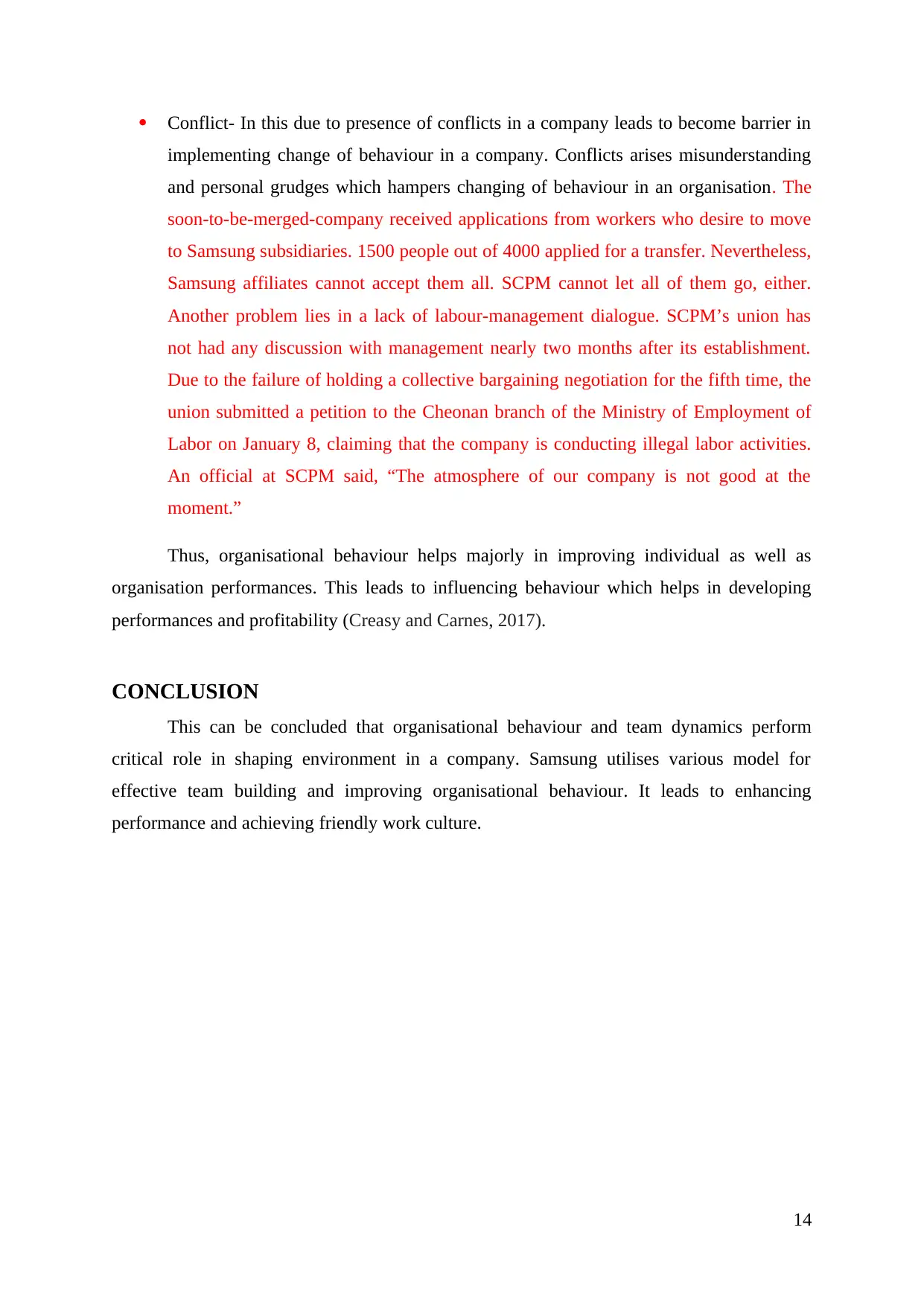
Conflict- In this due to presence of conflicts in a company leads to become barrier in
implementing change of behaviour in a company. Conflicts arises misunderstanding
and personal grudges which hampers changing of behaviour in an organisation. The
soon-to-be-merged-company received applications from workers who desire to move
to Samsung subsidiaries. 1500 people out of 4000 applied for a transfer. Nevertheless,
Samsung affiliates cannot accept them all. SCPM cannot let all of them go, either.
Another problem lies in a lack of labour-management dialogue. SCPM’s union has
not had any discussion with management nearly two months after its establishment.
Due to the failure of holding a collective bargaining negotiation for the fifth time, the
union submitted a petition to the Cheonan branch of the Ministry of Employment of
Labor on January 8, claiming that the company is conducting illegal labor activities.
An official at SCPM said, “The atmosphere of our company is not good at the
moment.”
Thus, organisational behaviour helps majorly in improving individual as well as
organisation performances. This leads to influencing behaviour which helps in developing
performances and profitability (Creasy and Carnes, 2017).
CONCLUSION
This can be concluded that organisational behaviour and team dynamics perform
critical role in shaping environment in a company. Samsung utilises various model for
effective team building and improving organisational behaviour. It leads to enhancing
performance and achieving friendly work culture.
14
implementing change of behaviour in a company. Conflicts arises misunderstanding
and personal grudges which hampers changing of behaviour in an organisation. The
soon-to-be-merged-company received applications from workers who desire to move
to Samsung subsidiaries. 1500 people out of 4000 applied for a transfer. Nevertheless,
Samsung affiliates cannot accept them all. SCPM cannot let all of them go, either.
Another problem lies in a lack of labour-management dialogue. SCPM’s union has
not had any discussion with management nearly two months after its establishment.
Due to the failure of holding a collective bargaining negotiation for the fifth time, the
union submitted a petition to the Cheonan branch of the Ministry of Employment of
Labor on January 8, claiming that the company is conducting illegal labor activities.
An official at SCPM said, “The atmosphere of our company is not good at the
moment.”
Thus, organisational behaviour helps majorly in improving individual as well as
organisation performances. This leads to influencing behaviour which helps in developing
performances and profitability (Creasy and Carnes, 2017).
CONCLUSION
This can be concluded that organisational behaviour and team dynamics perform
critical role in shaping environment in a company. Samsung utilises various model for
effective team building and improving organisational behaviour. It leads to enhancing
performance and achieving friendly work culture.
14
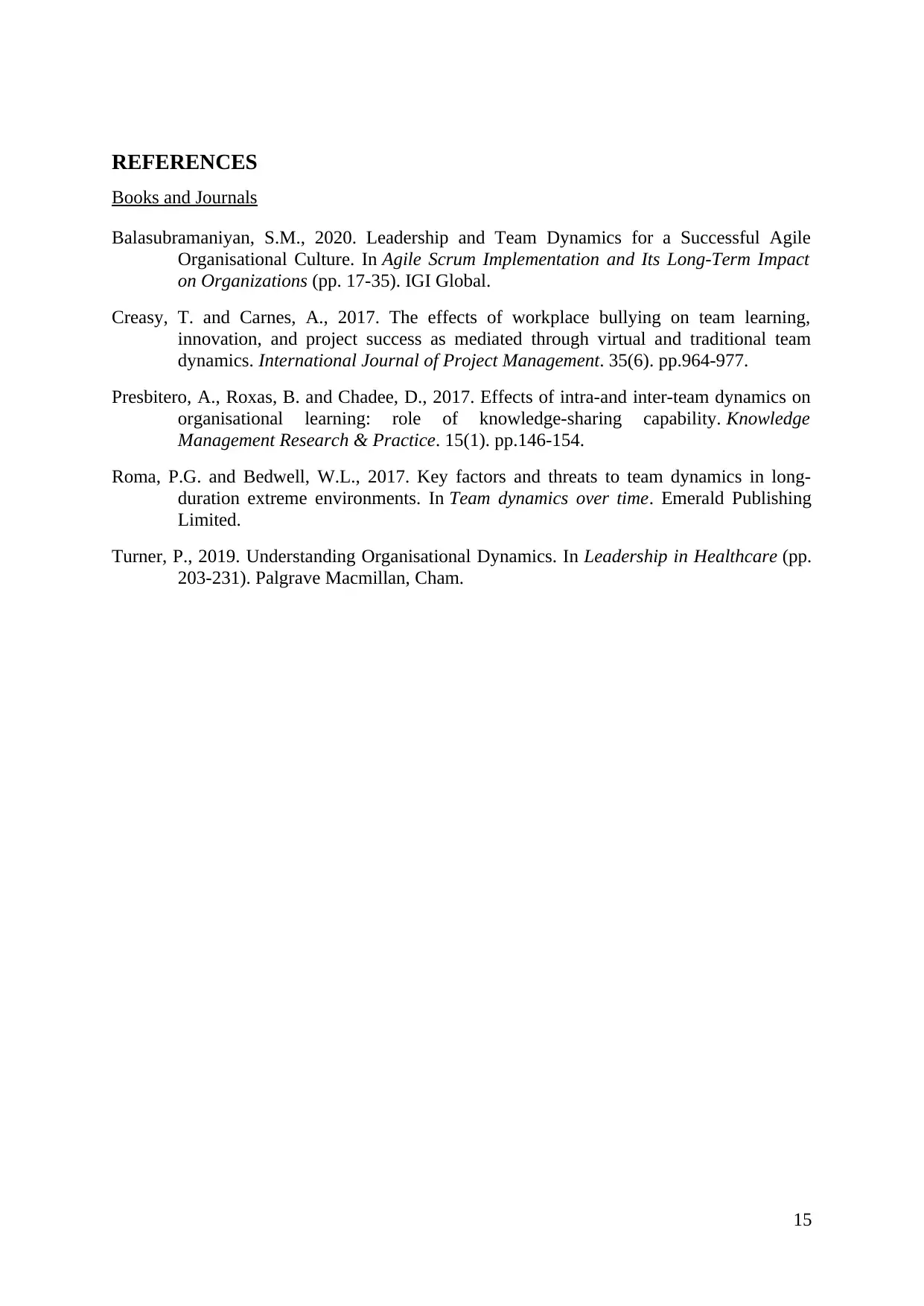
REFERENCES
Books and Journals
Balasubramaniyan, S.M., 2020. Leadership and Team Dynamics for a Successful Agile
Organisational Culture. In Agile Scrum Implementation and Its Long-Term Impact
on Organizations (pp. 17-35). IGI Global.
Creasy, T. and Carnes, A., 2017. The effects of workplace bullying on team learning,
innovation, and project success as mediated through virtual and traditional team
dynamics. International Journal of Project Management. 35(6). pp.964-977.
Presbitero, A., Roxas, B. and Chadee, D., 2017. Effects of intra-and inter-team dynamics on
organisational learning: role of knowledge-sharing capability. Knowledge
Management Research & Practice. 15(1). pp.146-154.
Roma, P.G. and Bedwell, W.L., 2017. Key factors and threats to team dynamics in long-
duration extreme environments. In Team dynamics over time. Emerald Publishing
Limited.
Turner, P., 2019. Understanding Organisational Dynamics. In Leadership in Healthcare (pp.
203-231). Palgrave Macmillan, Cham.
15
Books and Journals
Balasubramaniyan, S.M., 2020. Leadership and Team Dynamics for a Successful Agile
Organisational Culture. In Agile Scrum Implementation and Its Long-Term Impact
on Organizations (pp. 17-35). IGI Global.
Creasy, T. and Carnes, A., 2017. The effects of workplace bullying on team learning,
innovation, and project success as mediated through virtual and traditional team
dynamics. International Journal of Project Management. 35(6). pp.964-977.
Presbitero, A., Roxas, B. and Chadee, D., 2017. Effects of intra-and inter-team dynamics on
organisational learning: role of knowledge-sharing capability. Knowledge
Management Research & Practice. 15(1). pp.146-154.
Roma, P.G. and Bedwell, W.L., 2017. Key factors and threats to team dynamics in long-
duration extreme environments. In Team dynamics over time. Emerald Publishing
Limited.
Turner, P., 2019. Understanding Organisational Dynamics. In Leadership in Healthcare (pp.
203-231). Palgrave Macmillan, Cham.
15
1 out of 15
Related Documents
Your All-in-One AI-Powered Toolkit for Academic Success.
+13062052269
info@desklib.com
Available 24*7 on WhatsApp / Email
![[object Object]](/_next/static/media/star-bottom.7253800d.svg)
Unlock your academic potential
© 2024 | Zucol Services PVT LTD | All rights reserved.





